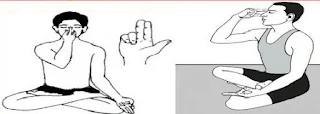Diabetes is a chronic disease that affects the body's ability to control blood sugar levels. It is divided into two main types: type 1 diabetes, which is an autoimmune disease that prevents the pancreas from making insulin, and type 2 diabetes, which is caused by a decrease in the body's ability to use insulin effectively.
Yoga from vedas is an ancient Indian practice that focuses on bringing the body, mind, and spirit together. Yoga includes a variety of asanas, pranayama, and meditation.
Boost your sexual power by Aizen Power
Aizen Power is a brand dedicated to providing men with effective and reliable solutions for enhancing their sexual performance and overall vitality. Their supplements are formulated using high-quality ingredients backed by scientific research, ensuring optimal results.Read more about globally praised here ...
Benefits of yoga for diabetes
Research has shown that yoga can help manage diabetes. Some of the potential benefits of yoga include:Helps control blood sugar levels.
Improves insulin sensitivity
Helps with weight loss
Reduces stress and anxiety
Improves heart health
Improves mental health
Yoga Asanas for Diabetes
There are many yoga poses beneficial for diabetes. Some popular choices include:
Paschimottanasana
Tadasana
This pose improves blood circulation, which can help control blood sugar levels.
Supta Bhujangasana
This pose helps stimulate the stomach and digestive system.
Dhanurasana
This pose helps make the spine flexible and improves blood circulation.
Viparita Karani asana
This pose helps stimulate the pancreas and adrenal glands.
Pranayama for Diabetes
Pranayama is an important part of yoga that focuses on breathing. Some of the pranayama that can help manage diabetes include:
Anulom Vilom
This pranayama helps reduce stress and improve blood circulation.
Anulom Vilom, also known as alternate nostril breathing, is a pranayama (breathing technique) from yoga. Here’s how you can practice it:
Sit comfortably: Find a comfortable seated position with your spine straight. You can sit cross-legged on the floor or on a chair with your feet flat on the ground.
Relax: Close your eyes and relax your whole body, especially your shoulders and face.
Hand position: Place your left hand on your left knee in a relaxed gesture (jñana mudra) or just comfortably on your lap. Use your right hand for the breathing technique.
Nasal breathing: Use your right thumb to close your right nostril and your right ring finger or little finger to close your left nostril.
Start breathing: Begin by closing your right nostril with your right thumb and inhaling slowly and deeply through your left nostril.
Switch sides: After a full inhalation, close your left nostril with your right ring finger or little finger, release your thumb from the right nostril, and exhale slowly and completely through your right nostril.
Continue alternating: Without pausing, inhale deeply through the right nostril, then switch sides again by closing the right nostril and exhaling through the left nostril. This completes one cycle.
Repeat: Continue this alternating pattern, focusing on slow, deep, and rhythmic breaths. Aim to keep the inhales and exhales of equal length.
Duration: Start with 5 minutes of practice and gradually increase as you become more comfortable with the technique.
Anulom Vilom helps balance the nadis (energy channels) in the body, promoting relaxation, mental clarity, and stress relief. It’s best practiced on an empty stomach and in a calm environment for optimal benefits.
Bhramari Pranayama
This pranayama can help control blood sugar levels.
This is a yogic breathing exercise, can potentially help in controlling blood sugar levels through several mechanisms.
Bhramari Pranayama is a calming breathing exercise that involves making a humming sound during exhalation. Here’s how you can practice it:
Sit Comfortably: Find a quiet place where you can sit comfortably, either cross-legged on the floor or in a chair with your spine straight and shoulders relaxed.
Hand Position: You can place your hands on your knees in a relaxed gesture known as "chin mudra," where you touch your index finger to the tip of your thumb, keeping the other fingers extended.
Closed Eyes: Close your eyes gently to help you focus inward.
Inhale deeply: Take a slow and deep breath in through your nose. Feel your lungs fill with air.
Exhale with Humming Sound: As you exhale slowly and steadily through your nose, make a humming sound similar to the buzzing of a bee (hence the name "bhramari"). The sound should be smooth and continuous.
Focus on the Hum: Concentrate on the sensation and vibration of the humming sound throughout your head and body.
Repeat: Continue this cycle for several rounds, aiming for about 5-10 breaths to start with. You can gradually increase this as you become more comfortable with the practice.
Reflect: After completing the rounds, sit quietly for a moment with your eyes closed and observe any sensations in your body, mind, and breath.
This Pranayama is known for its calming effect on the mind and nervous system, making it beneficial for reducing stress, anxiety, and promoting overall relaxation. Practice regularly for best results.Chronic stress can elevate blood sugar levels, so reducing stress through pranayama may help in maintaining healthier glucose levels. Regular practice of pranayama, including Bhramari, has been linked to improved insulin sensitivity. Insulin sensitivity is crucial for the body's ability to effectively utilize glucose from the bloodstream, thus regulating blood sugar levels.These practices are known to enhance circulation and oxygenation of tissues. Improved blood flow can support better functioning of insulin-producing cells in the pancreas and aid in glucose uptake by muscles and other tissues.These can influence the endocrine system, helping to balance hormones that regulate metabolism, including insulin and glucagon, which are crucial for blood sugar regulation.The meditative aspects of Bhramari pranayama promote mindfulness and awareness of bodily sensations. This heightened mind-body connection can lead to better self-care practices, including dietary choices and physical activity, which are essential for managing blood sugar levels.It's important to note that while Bhramari pranayama can be a supportive practice for managing blood sugar levels, it should complement, not replace, medical treatments prescribed by healthcare professionals. Always consult with a healthcare provider before making significant changes to your diabetes management routine.
Kapalabhati Pranayama
Kapalabhati Pranayama is a breathing technique in yoga that involves rapid and forceful exhalations followed by passive inhalations. Here’s how to practice it:
Sit in a comfortable position with your spine erect. You can sit cross-legged or on a chair with your feet flat on the ground.
Place your hands on your knees or in a mudra (hand gesture) such as Jnana mudra (tip of the thumb touching the tip of the index finger, with the other fingers extended).
Take a deep breath in through both nostrils.Forcefully and quickly exhale through both nostrils by contracting your abdominal muscles. The exhalation should be active and forceful, while the inhalation should be passive and natural.
Aim for a ratio of 1:2 between inhalation and exhalation. Start with a comfortable pace, gradually increasing the speed as you become more proficient.
Begin with a round of 30 exhalations, followed by a few normal breaths. Repeat for 3-5 rounds initially, gradually increasing with practice.
Maintain your focus on the exhalations, keeping the inhalations passive and relaxed. You may close your eyes to better concentrate.
Start with practicing for about 5 minutes and gradually increase the duration as your stamina improves. It's important not to strain yourself; if you feel dizzy or uncomfortable, stop and take a few normal breaths.
Kapalabhati Pranayama helps to cleanse the respiratory system, increase lung capacity, improve blood circulation, and energize the mind and body. It's also beneficial for improving digestion and enhancing concentration.
Avoid practicing Kapalabhati if you are pregnant, have high blood pressure, heart disease, hernia, gastric ulcers, or epilepsy, unless under the guidance of an experienced instructor.
Always practice pranayama under the guidance of a qualified yoga instructor, especially if you are new to these techniques. They can provide personalized guidance and ensure you're practicing safely and effectively.
Meditation for Diabetes
Meditation is a meditation practice that focuses on calming and focusing the mind. Meditation can help in managing diabetes as it helps reduce stress and improve mental health.
How to do yoga for diabetes
It is important to consult a yoga teacher before starting yoga for diabetes. The yoga teacher can help you choose the right asanas and pranayama that are safe and effective for you.
Some precautions of yoga for diabetes
It is important to take certain precautions while doing yoga for diabetes:
Monitor your blood sugar levels – It is important to check your blood sugar levels before and after yoga. If your blood sugar levels are too low, you should not do yoga.
Talk to your doctor – It is important to talk to your doctor before starting yoga for diabetes.
Start slowly – If you are a beginner, start slowly and increase your pace.
Listen to your body – If you feel any kind of discomfort, stop doing yoga immediately



.png)
%20(23).jpeg)
%20(24).jpeg)
%20(25).jpeg)
%20(26).jpeg)


.png)




